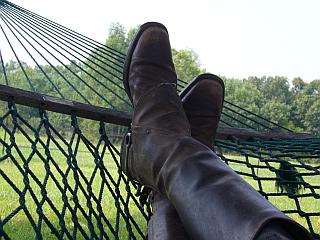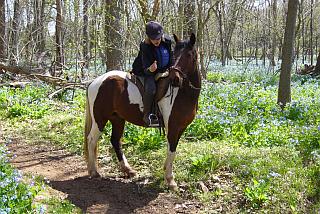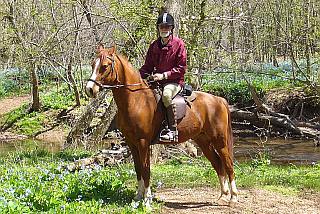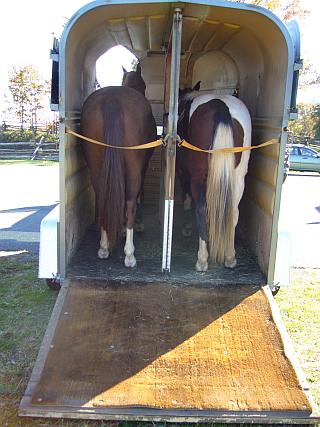Trail Riding Safety on Horse Back
by Debora Johnson
On the trail among the bluebells on Manassas Battlefield in Virginia.
Loaded and ready to go.
In the pictures above you can see that my husband has a pack attached to his saddle which carried everything. Now I have one, as well. That way we are really covered. Our packs attach securely to the backs of our saddles, do not flop up and down, do not rub, and really can carry allot of stuff. They are both made by the same manufacturer and are expensive but we feel really worth it. I might add that they did very well in the rain, too. I suggest you always have a plastic cover stuffed in your pack in case of an unexpected rain. We do. It does not take up much room and can be used for many purposes. Stowaway Packs
My husband, Bill, and I are trail riders. We do not show or compete in any way with our horses. We enjoy them, and each other. By training our horses, providing excellent care, both day- to-day and veterinary, grooming, bonding, and sharing experiences, we enjoy the many trails that are in Northern Virginia, Maryland and the District of Columbia. Nature looks very different from horse-back and provides an outlet from the insanity in Washington, D.C. We all know that horse-back-riding can be a very dangerous endeavor; even under the best circumstances. Therefore, it is important to br prepared for danger and disaster for both horse, rider and bystander.
This article may provide some help in how to address possible safety issues when trail riding. The following is a suggested list for day rides that are not too far from home. I will take this opportunity to suggest that if you do not have trailer hauling insurance in case of a problem it is really important to have it. Most road side service wreckers will not haul a horse trailer especially with a live cargo! US Rider Equestrian Motor Plan Roadside Assistance You really don't want to be without it.
In order to be safe while horseback riding or driving a horse, there are many considerations. It is very important to perform a safety check of your horse, rider, tack, facility and/or trail before starting out on your ride or drive. There are also several safety guidelines and items you should pack when you go trail riding.
Safety Guidelines for Trail Riders
- Trailer and Pulling Vehicle - Make sure both are in good working order before even thinking about trailering. Of course, have spare tires for both.
- Cell Phone - Always have a charged cell phone on you person, not in a pack. If you get dumped your cell phone may leave with your horse. We carry two cell phones. One is AT&T and the other is Verizon. The Verizon gets a better signal where we ride. We carry emergency numbers for Manassas Battlefield Park Communications as well as have 911 programmed into our phone.
- Map, compass, GPS - We used to carry just a compass, however, we now carry a GPS device, as well. If maps are available those are with us, too. In case you get into trouble it is most important to be able to give your location, location, location!
- Water - Always have water with you. We carry a small bottle attached to our belt and two regular size waters in our saddlepacks.
- First aid kit - We have a horse first aid kit in the trailer always. We also carry banamine paste and leg bandages with us for the horses. There is only so much you can take so think about what is most important. We have an ointment for infection, multi-purpose knives (mine is a Swiss Army Knife and Bill's is a leatherman. The leatherman has a pliers and lots of other stuff that is different than mine. {A cork screw, too] Between us, we are covered. We have used the plier many times to pull stuff out of the horse's hooves. It has also doubled as a shoe puller). As have a small flashlight, whistle, bug spray and an epi-pen. I am allergic to bees, wasps and hornets.
- Where to ride - Stay on the designated trails. They are marked. It is really easy to get lost--especially in the woods. In the Federal parks it is mandatory that you stay on the equestrian trails that are marked. Follow the rules because it is a privilege to ride in the parks.
- Health cards and ID - Carry identification and health card when you ride in case of an emergency.
- Identifications - Put a tag on your horse. Attach it to the saddle and put one in the saddlebags, as well. We put our names, telephone numbers (cellular and land line), the boarding facility information, and our vet's name and telephone number.
- Environment - Be mindful of the environment when you ride. Carefully cross streams, etc. trying not to pollute or break down the ecosystem. Erosion is a problem in areas where horses travel frequently, especially in wet conditions. Try not to let your horse drop manure in a stream, pond or any water area.
- Head wear - Always wear a helmet.
- Clothing - Always wear appropriate clothing.
- Plastic cover - Keep a small plastic cover in your saddle pack. They fold or roll up into a tight ball, do not take up much room, and can be used for many different purposes.
- Footwear - Always wear proper foot wear with proper soles and heels
- Partner - Try not to ride alone. If you must, let someone know the route you plan to take and when you should be expected home.
- Lameness - In case your horse goes lame get off and check his feet. Look to see if there is a rock, stone, pebble or something else stuck in his shoe. Look for bleeding or abrasions. Feel for heat and swelling. Walk your horse to a safe place where he can be picked up and transported back to the barn.
- Hot weather - Monitor your horse for dehydration/vital signs. Electrolytes/Dehydration and Horses
- Coggins - Always have a current Coggins in the glove compartment of your pulling vehicle. In most states it must show negative within the past year.
- Tissue - Carry a small Kleenex pack with you in case you have to make a "pit" stop!
- Weather forecast - Check the weather forecast in the area which you plan to ride. That will determine what kind of clothing you might need to take with you.
- Lightening - Never ride when there is lightening. Horses are a lightening magnet. It is really dangerous.
- Bailing twine - I always carry bailing twine in my pack. It is good for all kinds of stuff including fixing broken tack. That has happened to us on the trail. We were really glad that we had it along.
- Sunscreen - Wear sunscreen and use a lip protection such as balm.
- Snack - Carry a foiled snack of some sort such as granola bars. Make sure that it is packaged properly because insects can smell yummies as far as two miles away!
- Insect repellent - Use an insect repellent on yourself and your horse when necessary.
- Speed - Ride at a safe speed. Remember there are other people using the trails, too.
- Use common sense.
- Eating - It is best not to let your horse eat on the trail especially when you are in the saddle. It develops bad habits for your horse--he will always want to stop to eat and put his head down. Really annoying! Secondly, you do not know what is on the forage.
- Drinking - We encourage our horses to drink in the water sources on the trails. It keeps them from getting dehydrated and also they do not become finicky drinkers! However, we do check with the rangers to make sure the water is alright for the horses to drink. To date, there has never been a problem.
- Loading - We always trailer the horses without any tack. It is safer because there is nothing that can get hung up. We usually take a hay net that we have doubled so that the horses can amuse themselves while we are in transit. By doubling the hay net it makes it more difficult for them to pull the day out. The hay lasts much longer and makes very little mess. We use front leg wraps to protect their legs most of the time.
- Small saw - My husband carries a small, fold up saw in his pack. He got it at Lowes. It has come in handy many times on the trail when trees were down and had to be made passable.
 After the ride Bill takes a snooze!
|



